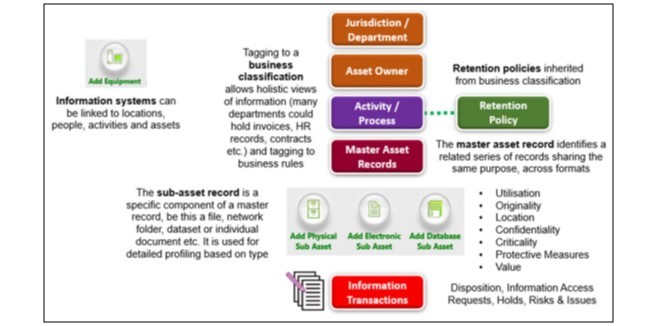
دانلود رایگان مقاله یک استراتژی برای مدیریت دارایی اطلاعاتی

چکیده
برای هر سازمان؛ اطلاعات دارایی حیاتی است، اما اطلاعات در تعاریف و توضیحات مدیریت دارایی نمی گنجد. این مقاله رشد تکنیک ها و استراتژی هایی برای مدیریت دارایی اطلاعاتی و مسائل و مشکلات مختلف تاثیر گذار بر رشد آن را بررسی میکند.
مقدمه
برای هر سازمانی اطلاعات یک دارایی تجاری مهم است. هر کاری که انجام میدهیم به نوعی شامل استفاده از اطلاعات است. این روند برای پشتیبانی و مطلع شدن از تصمیم گیری های موثر و تسهیل عملیات در حال انجام و ارائه برنامه، محصول و خدمات و به همین ترتیب شواهدی بر فعالیت، عملکرد، حقوق و تعهدات استفاده میشود. در عصر افزایش حجم اطلاعات و تحول تعهدات قانونی، یک سازمان برای قفل گشایی ارزش و شناسایی ریسک به دنبال نفوذ بر محتوای اطلاعات است، در این راستا مهم است که داده به خوبی محافظت شود، و به آسانی در دسترس باشد و به صورت مناسبی مدیریت شود.
به هر حال، اطلاعات اغلب در تعاریف مدیریت دارایی ظاهر نمیشوند. برای مثال، در ویکی پدیا، تعریفی از "دارایی های ملموس مانند ساختمان و دارایی های ناملموس مانند سرمایه انسانی، مالکیت معنوی، و حسن نیت و دارایی های مالی" با تشریح بیشتر دارایی های زیر ساختی و فیزیکی محسوس برای مثال "ساختارها، تولید، خدمات، برق، آب، ضایعات، و امکانات بازیافت ضایعات، شبکه های توزیع، سیستم های حمل و نقل، ساختمان ها" ارائه شده است (Wikipedia, 2015). با توجه به درک فنی از اهمیت اطلاعات، چرا وقتی به فرآیند مدیریت دارایی رسمی نگاه میاندازیم، یک فیل در اتاق می بینیم (یک کار بزرگ)؟
همه چیز در مورد پول
نقل قول خوبی از تحلیل گر گارتنر به نام Doug Laney که مسئله مدیریت دارایی اطلاعاتی را توضیح داد وجود دارد: " اینکه شرکت به ارزش مبلمان اداری خود حس بهتری دارد تا دارایی های اطلاعاتی، ناامید کننده است". یا: آیا ما بیشتر به پرکردن قفسه ها و کامپیوترها اهمیت میدهیم تا اطلاعات و چیزهایی که در آن ها هستند؟ شاید به این دلیل است که ارزش اطلاعات را نمیدانیم؟
ارزش اطلاعات تجاری بدون شک مانند یک دارایی نامحسوس و حسن نیت است. البته به صورت فزاینده ای کالایی شدن داده و اطلاعات را میبینیم، به خصوص با "کلان داده" تولید شده توسط اینترنت اشیا و غیره. Infonomics به عنوان یک مفهوم سریعا در حال رشد است، به ویژه با توجه به کارهای انجام شده گارتنر. شرکت نرم افزاری RSD در حال حاضر مشغول انجام پروژه های Infonomics را با HauteEcole de Gestion deGene`ve (دانشگاه HES-SO علوم کاربردی غربی سوئیس) است.
به هر حال – جدا از هزینه های خرید و نگهداری- در حال حاضر فقدان مدل های ایجاد شده برای اطلاعات برای تعیین سهم درآمد، ارزش بازار، و استهلاک و اثرات بر ترازنامه ها وجود دارد. اما به ما اجازه میدهد که امیدوار باشیم. امیدوارم زمانی وجود داشته باشد که بخشی مختص نقش حسابداری اطلاعات وجود داشته باشد. تا آن موقع، این مقاله بر روش های دیگر تضمین بهترین روش های مدیریت اطلاعات تعبیه شده در مبنای شرکت های بزرگ در برخی از راه های ایمن و سالم بحث میکند.
تفکر بر تعریف اطلاعات
اگر مدیریت دارایی اطلاعاتی یک فرآیند سیتماتیک از ارزش گذاری، دسته بندی، استقرار، امن سازی، استفاده، نگهداری، سنجش و نظارت و فروش دارایی ها به صورت موثر و کم هزینه باشد، سپس باید دامنه "اطلاعات" را در کسب و کار تجاری فهمید.
واحدهای اطلاعاتی شامل حقایق و دانش ارائه شده در بخش هایی با "محتوای" دیجیتال یا فیزیکی هستند، که در درجه اول در اسناد تجاری وجود دارند. برای تضمین استفاده سازگار از فرآیندها و حاکمیت باید به اطلاعات گذشته، صرف نظر از فرمت یا رسانه آن نگاهی بی اندازیم. بنابراین، باید شامل منابع داده اصلی باشیم که گزارش های کامپیوتری و دیگر نوع اطلاعات را تولید میکنند. بنابراین، دارایی های اطلاعاتی میتوانند دامنه گسترده ای را پوشش دهند، این دامنه شامل موارد زیر است:
• اشیایی سه بعدی مانند نمونه ای که بخشی از دنباله ممیزی را شکل میدهد.
• رکوردهای صوتی و تصویری.
شما واقعاً به عملکرد شرکتهای بزرگ نیاز دارید
من دوست دارم که ببینم همه سازمانها، با اندازه مناسب، دارای عملکرد شرکتی خاصی هستند که به مدیریت اطلاعات (دارایی)، پوشش استراتژی، حاکمیت و ارائه سرویس تخصیص داده شده است.
مدیریت اطلاعات باید به صورت ایده آلی یک تابع مرکزی، در برش متقاطعی از سازمان باشد، که هدف آن کنترل و ارائه منابع در راهی مشابه با دیگر عملکردها است که شامل مدیریت دارایی ها، مانند امورمالی، اموال و منابع انسانی است. این تضمین میکند که یک هدف؛ نقش و چشم انداز سازگار ارائه میشود که با دیگر اهداف کوتاه مدت و بلند مدت استراتژیک و زمینه سازمانی سازگار است.
Abstract
Information is a vital asset for any organization, but information does not often appear in definitions or descriptions of asset management. This article addresses the development of information asset management techniques and strategies and the various issues and problems that impact on that development.
Introduction
Information is a vital business asset for any organization. Everything we do does involve using information in some way. It is used to support and inform effective decisionmaking and facilitate ongoing operations and the delivery of programmes, products and services, as well as evidence activity, performance, rights and obligations. In the age of both ever increasing information volumes and evolving legal obligations, as an organization seeks to leverage their information content to unlock value and identify risk, it is increasingly important for their data to be suitably protected, readily accessible and properly governed.
However, information does not often appear in definitions of asset management. For example, on Wikipedia, at the time of writing, it offers a definition of ‘tangible assets such as buildings and to intangible assets such as human capital, intellectual property, and goodwill and financial assets’, with a further explanation of tangible physical and infrastructure assets as for example ‘structures, production and service plant, power, water and waste treatment facilities, distribution networks, transport systems, buildings’ (Wikipedia, 2015). Given our tacit understanding of the importance of information, why is it the elephant in the room when we look at formal asset management processes?
It’s all about money
There is a great quote by Gartner analyst Doug Laney who explains the problem of information asset management: ‘It’s frustrating that companies have a better sense of the value of their office furniture than their information assets’. Or as I spin it: Do we know more about our filing cabinets and computers than about the information they contain? Perhaps it is because we do not know how to value information?
The business value of information as an intangible asset/ goodwill is undoubted and of course increasingly we are seeing the productization of data and information, especially with the ‘big data’ generated by the Internet of things and so on. Infonomics as a concept is rapidly developing, particularly with the work being undertaken by Gartner. Also the software company RSD is currently conducting an Infonomics project with Haute Ecole de Gestion de Gene`ve (HES-SO University of Applied Sciences Western Switzerland).
However – aside from acquisition and maintenance costs – currently there are a lack of established models for information to determine revenue contribution, market value and depreciation as well as other impacts on the balance sheet. But let us not give up hope now. There hopefully will be a time when part of our role will be that of information accountant. Until then, this article discusses other ways to ensure that information management best practices are embedded into the corporate psyche in the same way that health and safety are.
Musings on the definition of information
If information asset management is a systematic process of valuing, classifying, deploying, securing, utilizing, maintaining, measuring, monitoring and disposing of assets efficiently and cost-effectively, then we must understand the scope of ‘information’ in business processes.
Information units contain facts and knowledge presented in physical or digital ‘content’ containers, a primary one of which within business is the document. To ensure the consistent application of processes and governance we must therefore look at information holistically, irrespective of format or medium. We must also, therefore, include the underlying data sources that generate computer reports and other information types. Thus, information assets can cover a broad range, including:
3D objects such as samples that form part of an audit trail;
audio and video recordings;
You really need a corporate function
I would like to see all organizations, where their size justifies this, having a dedicated corporate function for information (asset) management, covering strategy, governance and service delivery.
Information management should ideally be a central function, cross-cutting of the organization, subject to controls and given resources in the same way as other functions that involve management of assets, such as finance, human resources and property. This ensures that a consistent purpose, role and vision are delivered that aligns with the overall purpose and the strategic goals and themes of the organization.
چکیده
مقدمه
همه چیز در مورد پول
تفکر بر تعریف اطلاعات
شما واقعاً به عملکرد شرکتهای بزرگ نیاز دارید
اتصال به پایین
کسب و کار معمولی
ارتباط، ارتباط و ارتباط!
پیامها و اصول کلیدی
تفکر بر تاکتیک ها و روش ها
ثبت، ثبت، ثبت!
پس یک دارایی چیست ( در IAR)؟
نگاه مختصری به دسته بندی داده
دسته بندی امنیت
طبقه بندی حساسیت
نگهدارای و فروش
نتیجه گیری با یک جمله
Abstract
Introduction
It’s all about money
Musings on the definition of information
You really need a corporate function
Binding it down
Business as usual
Communicate, communicate, and communicate!
Key principles and messages
Thoughts on tactics and methods
Register, register, and register!
So just what is an asset (within an IAR)?
A brief look at data classification
Security classification
Criticality classification
Retention and disposal
A one sentence conclusion
